Key Takeaways
- Investors require different outcomes from their investments, a one-size-fits-all passive approach is unlikely to work for everyone. Horizon believes tactical strategies can offer the flexibility to more accurately customize portfolios to meet unique investor needs and long-term financial goals.
- Tactical strategies seek opportunities and attempt to minimize perceived risk in markets.
- Horizon implements tactical allocation both within asset classes, and across asset classes, to create a unique investment outcome. We believe transparency in process is essential for matching client objectives with the right investment strategy.
Tactical investment strategies shift allocations in a portfolio to take advantage of shorter-term market opportunities with the goal of improving the trade-off between risk and reward. Similar to how an athletic coach may elect to switch a game plan mid-match to address the opposing team’s strengths and weaknesses, a tactical investment manager may adjust their portfolio exposures to seek a desired outcome. Compared to more passive or strategic investing styles, tactical strategies are typically more active and often feature larger and more frequent portfolio changes.
Figure 1 shows the spectrum of common asset allocation investment styles. Advocates of passive investing believe that the stock market is unpredictable, and therefore the best portfolio makes no changes in response to market information. By comparison, active strategies account for market conditions by adjusting the portfolio’s holdings over time. Strategic approaches to active management may maintain consistent portfolio tilts or change slowly over time, while tactical approaches respond more quickly to market information.
Figure 1: The spectrum of passive and active strategies.

Seeking Opportunity with Tactical Management
Tactical implementations may vary significantly from manager to manager. Two of the most common types of tactical strategies occur within asset classes and across asset classes.
Tactical Allocation Within an Asset Class
Tactical allocation within an asset class begins with setting a strategic asset allocation, and then adjustments are made to the holdings within the specific asset classes, in an effort to take advantage of market trends or opportunities. Allocation adjustments in this context are typically applied to broad baskets of stocks that share similar characteristics but may respond differently to various market conditions.
These characteristics may include the following:
- Geography – US or international stocks
- Style – high-growth or low-growth companies
- Size – large, mid, and small-cap companies
Figure 2 shows the performance differences between equity allocations over the last five years. Even within such a short time frame, there has been considerable variation in the annual spread of returns ranging from a low of 13% in 2019 to a high of 35% in 2021. While large spreads introduce the risk of underperformance, they also represent a potential opportunity for effective tactical managers.
Figure 2: A chart of broad global equity factors from 2018 through 2022.
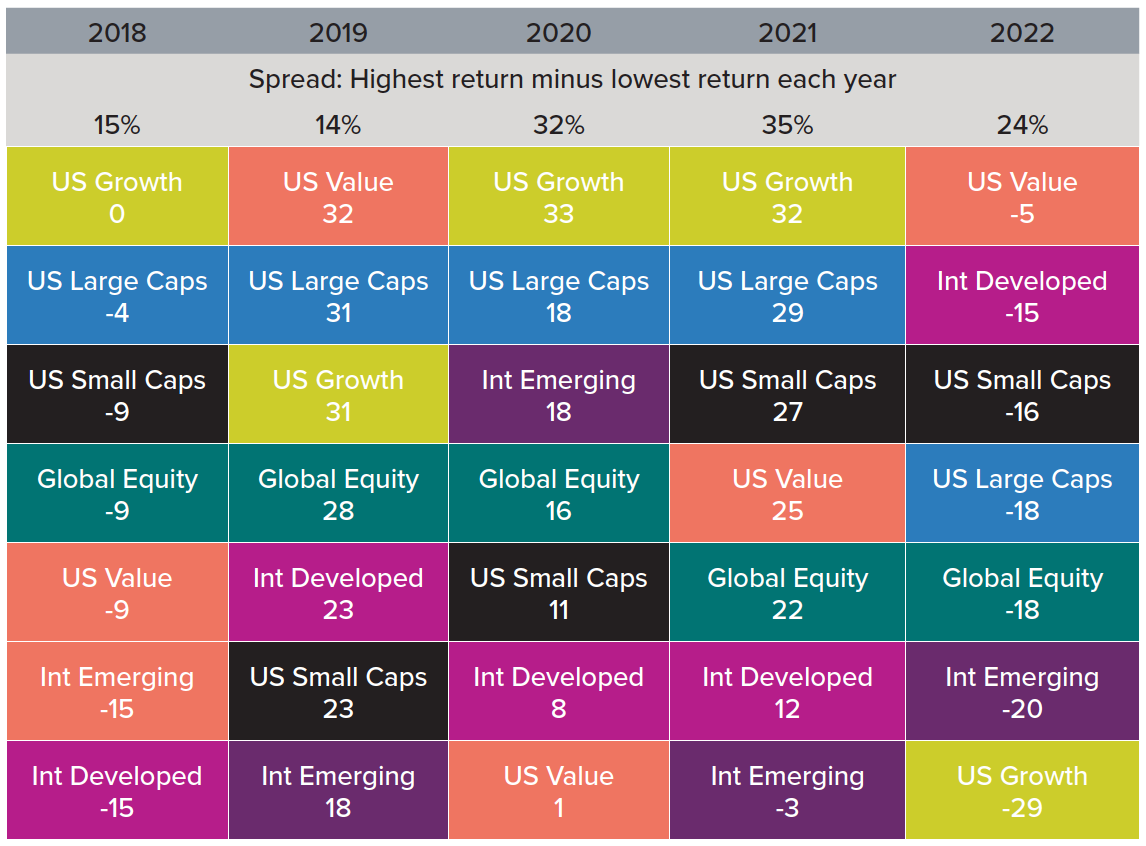
Source: Indices from Bloomberg, calculations by Horizon Investments. Global Equity is the MSCI Global Index, Int Developed is the MSCI Ex-USA Index, Int Emerging is the MSCI Emerging Markets Index, US Value is the S&P 500 Value Index, US Growth is the S&P 500 Growth Index, and US Small Caps is the S&P 600 Small Cap Index. It is not possible to invest directly in an index. Please see attached disclosures.
Figure 3 shows an example of the differences in activity over time between a strategic and tactical approach. For the purpose of this illustration, the strategic allocation does not change exposures. However, for tactical strategies within an asset class, the manager may adjust the allocation to each equity component based on market conditions while keeping the overall stock or bond allocation the same.
Figure 3: Illustrative example of exposure changes of tactical and strategic allocations.
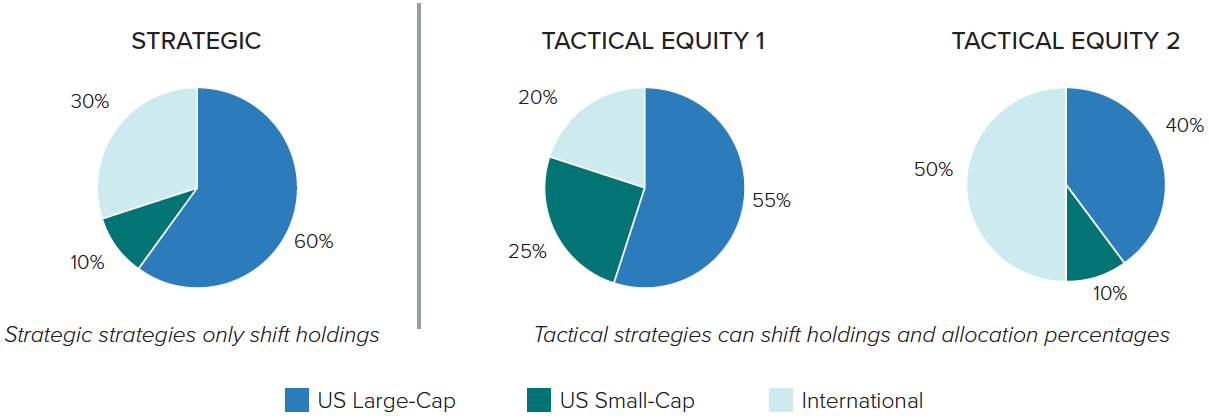
Source: For illustrative purposes only by Horizon Investments. Not representative of any specific account.
Tactical Allocation Across Asset Classes
In contrast, tactical allocation across asset classes means the proportions of the portfolio allocated to stocks, bonds, or cash are expected to change over time depending on market activity. Because allocations can greatly vary, these strategies typically display a broader range of risk and return expectations than tactical allocations within an asset class.
For example, a tactical strategy may shift allocations across stocks and cash with the goal of adjusting the exposure to equities within certain risk limits. Therefore, if stocks go down in value or otherwise risk increases, the proportion allocated to stocks may be reduced in an attempt to minimize further losses.
Figure 4 shows an example of the active change in exposure to stocks and bonds that a tactical manager may make in response to market conditions. Notice that the stock and bond allocation changes dramatically over the two periods, which may have a larger impact on strategy expectations than adjusting allocations within an asset class.
Figure 4: Illustrative example of tactical allocations.
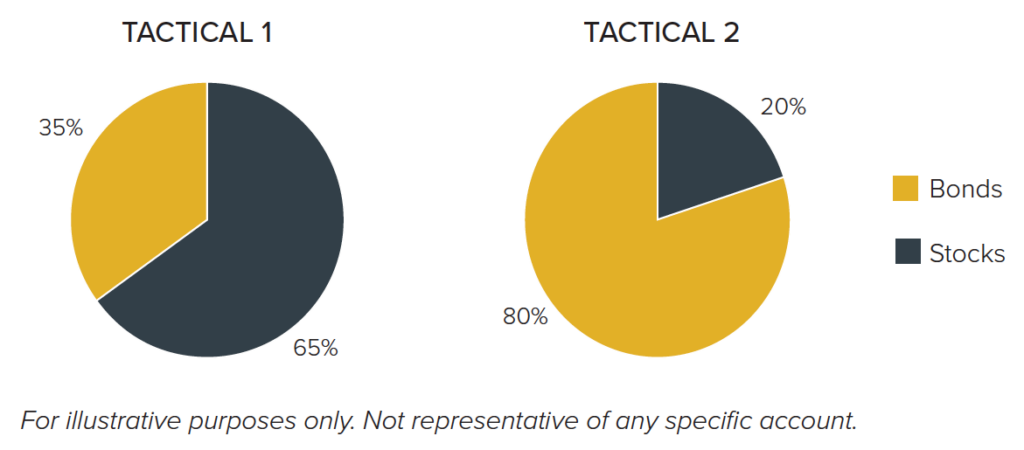
Figure 5 compares the Morningstar Tactical Allocation category to broad global stocks (represented by the MSCI World Index). The lower volatility of the tactical allocation, represented by the darker line, is apparent – maximum gains and drawdowns are both smaller than they are for global stocks. Tactical allocation strategies come in many different shapes and sizes; therefore, we believe managers must be transparent about their specific approach to create consistency in expectations.
Figure 5: Rolling annual returns of Global stocks and Tactical Allocation
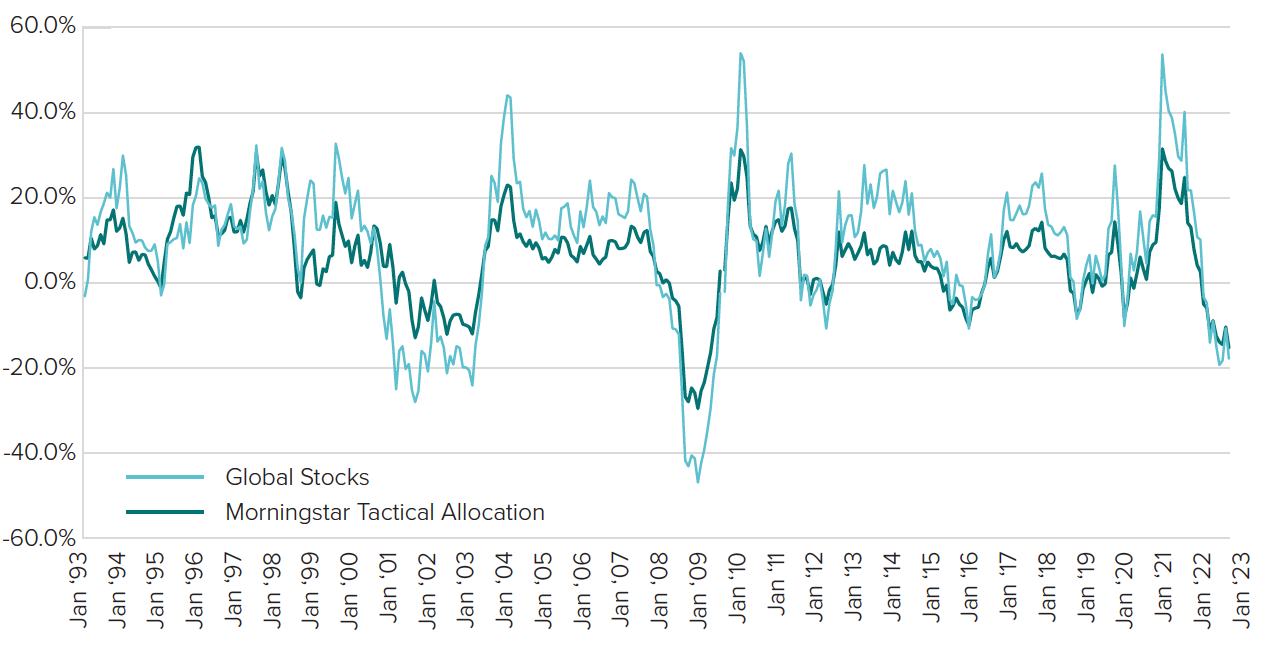
Source: MSCI World Index and Morningstar Tactical Category over the last 30 years from 1993 – 2022, calculations by Horizon Investments. It is not possible to invest directly in an index. Please see attached disclosures.
Tactical Allocation within Horizon’s Goals-Based Framework
Horizon’s Goals-Based Philosophy has been developed and refined after years of practical experience working with advisors across different market environments. We focus on providing investors with investment solutions that align with their financial plans. Although past performance is not an indicator of future results, tactical strategies, both within and across asset classes, have historically performed better, on the downside, than strategic strategies when returns were highly dispersed or when markets exhibited above-average volatility (as shown in Figure 5). Those two conditions often coincide with market downtrends, and Figure 6 shows that, on average, tactical strategies have outperformed global stocks during years when stock returns are negative. And as many investors have experienced, volatile and difficult market environments can lead to investment behaviors that may disrupt an investment plan.
Figure 6: Downside performance of the Morningstar tactical allocation category verses global stocks
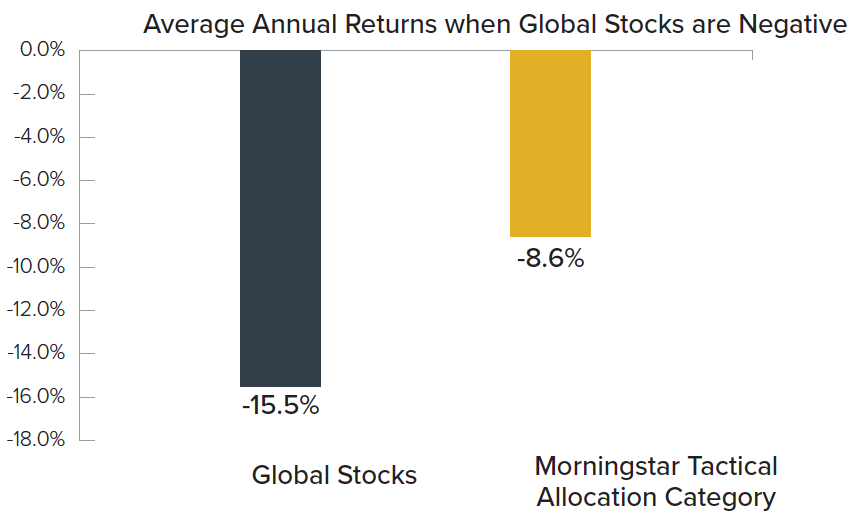
Source: MSCI World Index and Morningstar Tactical Category over the last 30 years from 1993 – 2022, calculations by Horizon Investments. It is not possible to invest directly in an index. Please see attached disclosures.
Because of the potential for tactical strategies to reduce risk when needed and thereby improve an investor’s experience, Horizon views them as core features of an effective goals-based investment solution. Horizon deploys tactical strategies within our design of goals-based portfolios in two distinct ways.
- Accumulation: For clients with an accumulation objective and a long investment horizon, we believe tactical allocation within an asset class may be appropriate because of its ability to respond to changing market environments while keeping the long-term desired asset allocation intact.
- Preservation and distribution: For clients with a primary objective of preservation or distribution, and a shorter investment horizon, we believe tactical allocation across asset classes may be appropriate since it can provide a greater degree of risk mitigation.
In either case, tactical strategies can also be blended with more strategic or passive choices to further enhance diversification across investing styles, as different types of markets may favor one approach over the other.
Horizon believes tactical strategies can offer the flexibility to more accurately customize portfolios to meet investors’ needs and seek long-term investment objectives.
Past performance is not indicative of future results. This information is for educational use only and should not be considered to be a recommendation to buy or sell a security or to adopt a particular investment strategy. The opinions expressed here are not investment recommendations, but rather opinions that reflect the judgment of Horizon as of the date of the report and are subject to change without notice. Opinions expressed do not take into account specific client investment objectives.
Tactical allocation is not suitable for all investors and can carry additional risks. Market values can change daily due to economic and other events that affect markets, countries, companies or governments. It is difficult to predict the timing, duration, and potential adverse effects of events. While Horizon’s strategies were designed with the goal of limiting drawdown, Horizon is not able to predict all market conditions and ensure that they will always limit drawdown as designed. Accounts are not fully protected against all loss. All investing involves risk of loss, and in periods of market growth, risk mitigation strategies can be expected to lag in performance behind equity strategies that do not focus on risk mitigation. Any risk management processes described herein include an effort to monitor and manage risk, but should not be confused with and do not imply low risk or the ability to control risk.
References to indices, or other measures of relative market performance over a specified period of time are provided for informational purposes only. Reference to an index does not imply that any account will achieve returns, volatility or other results similar to that index. The composition of an index may not reflect the manner in which a portfolio is constructed in relation to expected or achieved returns, portfolio guidelines, restrictions, sectors, correlations, concentrations, volatility or tracking error targets, all of which are subject to change. It is not possible to invest directly in an index. Information obtained from third party sources is believed reliable but has not been vetted by the firm or its personnel. The indices and Morningstar categories shown are for illustrative purposes only and are not representative of any specific account. They are unmanaged and do not have fees or expense charges, which would lower returns.
The MSCI World Index captures large and mid-cap representation across 23 Developed Markets (DM) countries. The MSCI World ex USA Index captures large and mid cap representation across 22 of 23 Developed Markets (DM) countries excluding the United States. The MSCI Emerging Markets Index captures large and mid cap representation across 24 Emerging Markets (EM) countries. The S&P 500 Value Index is composed of the value companies in the S&P 500. The S&P 500 Growth Index is composed of the growth companies in the S&P 500. The S&P SmallCap 600® seeks to measure the small-cap segment of the U.S. equity market. The Morningstar Tactical Allocation Category represents portfolios seeking to provide capital appreciation and income by actively shifting allocations across investments. These portfolios have material shifts across equity regions, and bond sectors on a frequent basis. Horizon Investments is an investment advisor registered with the U.S. Securities and Exchange Commission. Registration does not imply a certain level of skill or training. More information about Horizon’s investment advisory services can be found in our Form ADV Part 2, which is available upon request.
Horizon Investments, the Horizon H, and Goals-Based Planning are all registered trademarks of Horizon Investments, LLC.
© 2023 Horizon Investments, LLC.
HI-TM-0323
